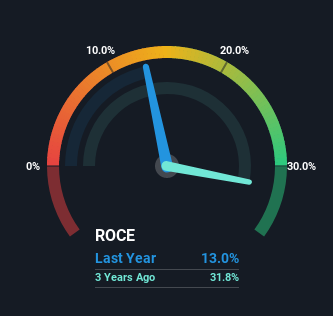- Hong Kong
- /
- Construction
- /
- SEHK:9900
Gain Plus Holdings (HKG:9900) Is Reinvesting At Lower Rates Of Return
If you're not sure where to start when looking for the next multi-bagger, there are a few key trends you should keep an eye out for. One common approach is to try and find a company with returns on capital employed (ROCE) that are increasing, in conjunction with a growing amount of capital employed. If you see this, it typically means it's a company with a great business model and plenty of profitable reinvestment opportunities. Having said that, from a first glance at Gain Plus Holdings (HKG:9900) we aren't jumping out of our chairs at how returns are trending, but let's have a deeper look.
What Is Return On Capital Employed (ROCE)?
For those that aren't sure what ROCE is, it measures the amount of pre-tax profits a company can generate from the capital employed in its business. The formula for this calculation on Gain Plus Holdings is:
Return on Capital Employed = Earnings Before Interest and Tax (EBIT) ÷ (Total Assets - Current Liabilities)
0.13 = HK$33m ÷ (HK$338m - HK$82m) (Based on the trailing twelve months to September 2022).
So, Gain Plus Holdings has an ROCE of 13%. On its own, that's a standard return, however it's much better than the 6.9% generated by the Construction industry.
Check out our latest analysis for Gain Plus Holdings

Historical performance is a great place to start when researching a stock so above you can see the gauge for Gain Plus Holdings' ROCE against it's prior returns. If you're interested in investigating Gain Plus Holdings' past further, check out this free graph of past earnings, revenue and cash flow.
So How Is Gain Plus Holdings' ROCE Trending?
In terms of Gain Plus Holdings' historical ROCE movements, the trend isn't fantastic. Around five years ago the returns on capital were 30%, but since then they've fallen to 13%. On the other hand, the company has been employing more capital without a corresponding improvement in sales in the last year, which could suggest these investments are longer term plays. It may take some time before the company starts to see any change in earnings from these investments.
On a side note, Gain Plus Holdings has done well to pay down its current liabilities to 24% of total assets. That could partly explain why the ROCE has dropped. Effectively this means their suppliers or short-term creditors are funding less of the business, which reduces some elements of risk. Some would claim this reduces the business' efficiency at generating ROCE since it is now funding more of the operations with its own money.
The Bottom Line
In summary, Gain Plus Holdings is reinvesting funds back into the business for growth but unfortunately it looks like sales haven't increased much just yet. Since the stock has declined 33% over the last five years, investors may not be too optimistic on this trend improving either. On the whole, we aren't too inspired by the underlying trends and we think there may be better chances of finding a multi-bagger elsewhere.
If you'd like to know about the risks facing Gain Plus Holdings, we've discovered 3 warning signs that you should be aware of.
If you want to search for solid companies with great earnings, check out this free list of companies with good balance sheets and impressive returns on equity.
Valuation is complex, but we're here to simplify it.
Discover if Hong Kong Zcloud Technology Construction might be undervalued or overvalued with our detailed analysis, featuring fair value estimates, potential risks, dividends, insider trades, and its financial condition.
Access Free AnalysisHave feedback on this article? Concerned about the content? Get in touch with us directly. Alternatively, email editorial-team (at) simplywallst.com.
This article by Simply Wall St is general in nature. We provide commentary based on historical data and analyst forecasts only using an unbiased methodology and our articles are not intended to be financial advice. It does not constitute a recommendation to buy or sell any stock, and does not take account of your objectives, or your financial situation. We aim to bring you long-term focused analysis driven by fundamental data. Note that our analysis may not factor in the latest price-sensitive company announcements or qualitative material. Simply Wall St has no position in any stocks mentioned.
About SEHK:9900
Hong Kong Zcloud Technology Construction
An investment holding company, engages in the provision of subcontracting works for public and private sectors in Hong Kong.
Flawless balance sheet with solid track record.
Market Insights
Community Narratives



